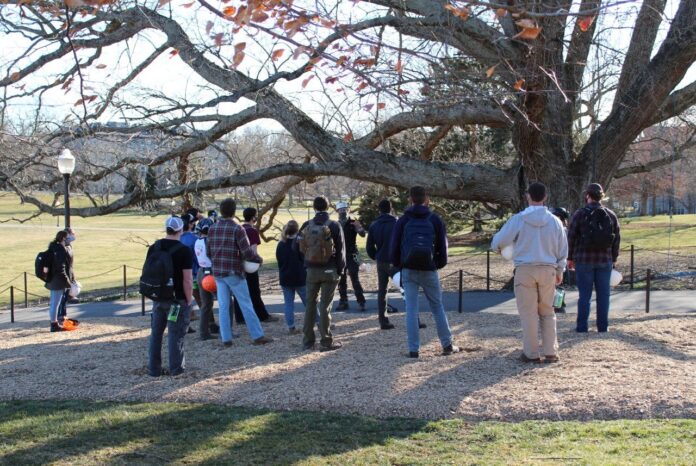The Alwood Oak, one of the most distinctive trees on the Virginia Tech campus, is taking on a new role this year: teaching assistant.
Raised from seedling by renowned entomologist and Virginia Tech Professor William Bradford Alwood and planted at the northern end of the Drillfield near the end of the 19th century, the 100-foot-tall bur oak is one of several campus trees currently being cared for by Jamie King, Virginia Tech’s first-ever arborist.
This month, King, an alumnus of the College of Natural Resources and Environment, collaborated with Associate Professor Eric Wiseman of the Department of Forest Resources and Environmental Conservation to allow students in Wiseman’s Arboriculture Field Skills class to see firsthand how to care for old trees like the Alwood Oak and participate in protection strategies used by urban foresters and arborists.
VIDEO: Cherished Oak Tree Provides A Learning Opportunity
“The biggest challenge in urban forestry is dealing with a tree’s proximity to human activities,” said King, who served as the City of Roanoke’s arborist prior to joining the Virginia Tech Division of Campus Planning, Infrastructure, and Facilities in 2019. “Development, foot and vehicle traffic, and soil compaction can all have significant impacts on tree health. And the natural aging processes for a tree, where they begin to shed limbs as they get older, requires careful attention.”
Another risk to large trees is lightning. Wiseman’s students had a chance to talk to professional arborists contracted to check the tree’s lightning protection system, which uses copper wires to transmit electricity directly into the ground instead of through the tree.
The students also learned about support systems utilized to prevent structural damage to big trees, and they got their hands dirty — or at least sappy — installing a brace rod in a nearby tree.

“The chance to be hands on with activities has been an extreme confidence booster,” said Cydney Chambers, a junior majoring in forest resources management. “I feel much more confident applying for jobs knowing I’ve actually practiced some of the skills we’ll be expected to use in the future.”
That is the goal for Wiseman, who said that this lab is an important step from understanding the science to seeing how that science plays out in real time.
“This course is all about the practice of arboriculture,” he said. “In the fall, our lab focuses on the science behind trees living in built environments, and we spend a lot of time observing, measuring, and evaluating trees. In the spring, we get into the practice side of the science.”
King, who studied under Wiseman as an undergraduate before pursuing a career in arboriculture, recognizes the important role that trees have in enhancing life for all Hokies.
“I feel a great deal of responsibility,” said King, who aims to develop an urban forester internship program for students. “There are a lot of people in the field who know and care about the trees on campus. Trees are vital to everyone’s experience at Virginia Tech, and preserving and enhancing that resource is a large part of what keeps me motivated.”
Ben Stauffer, a junior majoring in forest resources management, recognizes the important role that trees play in enhancing the experiences for students.
“Not only are we benefiting from the ecosystems services trees provide, but they contribute to the unique aesthetic that the campus has,” he said. “Fall foliage is always commented on and shared across social media, and on warm days people all over campus are sitting beneath the trees or tying slack lines to them.”
And sometimes Virginia Tech students are among the trees, drilling holes and bolting limbs and learning more about the work of keeping our campus green.
– David Fleming

